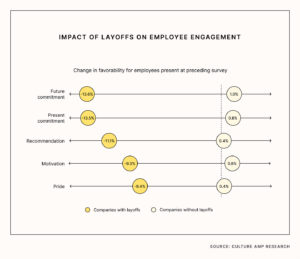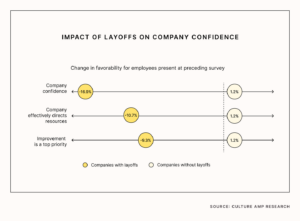“Trust is built in drops and lost in buckets.”
These are the words of Didier Elzinga, CEO of Melbourne-based HR software firm Culture Amp, reflecting on his experience of navigating a difficult transition.
Making staff layoffs can be a shock for any company, but the impact can be more profound in highly collaborative environments like the company Elzinga has built.
In 2023, having commissioned a survey on leadership approaches to layoffs, Culture Amp then faced its own cuts.
In the edited interview below, Elzinga dispels some of the myths surrounding staff layoffs and shares his learnings on managing change, dealing with fear and more.
1. Myth: Just drop the bottom 10%
“There are a lot of myths that get thrown around. And one of the classic ones is people saying, just drop the bottom 10%. And it’s just not true.
“You don’t have the tools to figure out who those people are. No matter how well you run the process, you will make mistakes and good people will leave either because you chose them or because they get annoyed with the process.
“So the first thing is to take that off the table. It doesn’t mean that you don’t necessarily look at performance as part of the process, but that’s not the driving factor.
“Either you’re just in a dire situation and you have to get smaller and you have no real choice so basically 10% or 20% of people have to go, and it’s that brutal. If that’s what it is, be honest about it.
“Or, it’s because we’re looking at ourselves saying, ‘This is not the company that’s going to be successful in the future. We’re going to have to reshape the company’.
“And that’s a different process. If you’re doing the second one, you don’t go to everyone and say, ‘Tell me the 10% that you don’t need’. You actually have to be much more strategic about which roles to keep and which not. So going in, know why you’re doing it and be really clear about that.”
2. Myth: This is a 30- or 60-day change management exercise
“You don’t just do layoffs and then a month later everyone bounces back. Our survey data showed it’s actually much more significant and it takes almost a year, sometimes a year and a half, for people to get back to the sorts of experiences that happened pre-layoffs.
“It’s not necessarily the measures that are put into place. It’s more about what’s actually going on underneath and this informs us as leaders – that you can’t diminish how big a change this is.”

Culture Amp’s survey data found that layoffs had a negative impact on employees’ present and future commitment, motivation and pride levels.
“Layoffs can be the right thing to do. But you need to give people a sense of what’s coming and why, and help people understand it. But even if you do, it’s still a shock.
“Trust is built in drops and lost in buckets. Layoffs reset you, and it will take a long time for you to rebuild that trust with people.
“So probably the thing that we see people taking away from this data is: it’s not a 30- or 60-day change management exercise, then post-layoffs get back to business. It’s more a case of, ‘We’ve done it. We actually have to focus on this for at least the next year to help get people back to a place where we can put it behind us’.”
3. Myth: Strong teams will bounce back quickly
“One surprising survey outcome is that companies with really good engagement pre-layoffs aren’t immune. In reality, collaborative teams take the longest time to rebuild trust.
“It goes back to this idea that layoffs are at some level a breach of trust with your employees, and it changes things.
“We found it was companies with the lowest engagement that bounced back the fastest – I guess, because people didn’t expect much to begin with.
“But in companies with strong cultures, you can’t rely on the fact that you had good engagement pre-layoffs to automatically assume that everything will be fine. You have to put a lot of work back in to get back to where it was.”

Culture Amp’s survey found layoffs caused staff members’ confidence in the company they worked for to plummet.
4. Myth: Make laid-off people leave right away
“The perceived wisdom with layoffs is that on that day, the people that are leaving are gone. And the reason for that is to corral the interruption as you don’t want those people’s severe anxiety, which is real, to spill over into everybody else. But that’s a really poor way of processing grief.
“In reality, you need to let people say goodbye and accept that if they are frustrated it is your job to hear and see that.
“The vast majority of people that are leaving did nothing wrong. The day before they were your friends and colleagues, people that you cared about and trusted. And suddenly they’re gone.
“So actually consider creating a little more space between the decision being made and people being told, to actually allow people to say goodbye, to allow people to sit down and to recognise that it’s not all going to be pretty.
“Some of those people are going to be really upset and frustrated and they’re going to want to tell you that. And as a leader that’s what your job is. You have to see that, you have to hear it. You have to realise that at some level, even if this is the right decision and not choosing to do layoffs would have been a bigger leadership failure, not bearing witness to the pain and the suffering that those layoffs create is also a failure of leadership.”
A different approach to layoffs
“You can’t diminish how big a change this is. It can be the right thing to do. But even if you do, it’s still a shock.
“And you have to take that on board when you’re thinking about what’s going to happen next.
“Layoffs are about grief, both for the people leaving, but also for the people that stay. Survivor guilt is a real thing. So how do we as an organisation process the grief of the people leaving and also the people staying? That’s the critical thing to sit down and figure out.
“We took on board a lot of the things that we learnt through our research.
“We created an extra week off at the end once layoffs were announced, to allow people to say goodbye.
“We ran Ask Me Anything (AMA) sessions internally, not just for the staff members that were staying, but also for those leaving. And some of those were really challenging, because some people were legitimately annoyed, upset and frustrated. But an important part of managing the experience is actually creating that space.
“And we established a channel in Slack – an internal communications tool – for those leaving and the people that were still coming to talk to each other and share those things, because not everybody wants to do it in person. Some people need a space, not a person, to talk to.”
Why prioritisation is vital after layoffs
“It’s essential to acknowledge what has happened and understand that just because people still have a job, they’re not necessarily going to just be happy about that. There are people that aren’t going to understand why we made those choices. And so a lot of it comes back to re-communicating what we’re doing and then focusing on ruthless prioritisation.
“Going from having 100% of your resources to having 80 or 90%, and yet at the same time you’re trying to grow… you can’t just ask everybody to do more with less.
“We can’t just expect people to go, ‘Ah cool, I’m here and I have a job now I’m going to work harder’. No they won’t; they’re going to find it even harder, because they’re stressed and they’re frightened.
“So how do we get everyone aligned on what’s most important?
“We established a Situation Room, where twice a week we share company-level strategic objective updates and it’s really designed to give everyone in the company a bird’s eye view on what’s going on. And we actually overhauled and shifted the way we were communicating in that meeting.
“We focused it down and said, ‘Here are the five key numbers for the whole company in priority order’. Cash was number one, as it was for a lot of companies. After the layoffs, we were able to go, ‘That’s still important, but that’s not priority anymore. Another metric is the priority’. And so we go through them in priority order and that helps people understand that here’s where we’re focusing our attention.
“Managing burnout and all the work that needs to be done is a perennial challenge, and prioritisation is really the only way to navigate that.
“We have to look after the people we’ve got. We’ve got to help them perform at a really high level and we have to figure out how we can all do that collectively for a very, very long time.”
This post is republished with permission from the World Economic Forum. You can read the original article here.
Related Posts
- The secret to retaining your employees? Focus on career advancement
- Need to manage change? Take this 100% free course in Adaptive Leadership for purpose-driven organisations
- ‘Never let a good crisis go to waste’: How to keep HR relevant in challenging times
- How to help your employees with back-to-work anxiety



